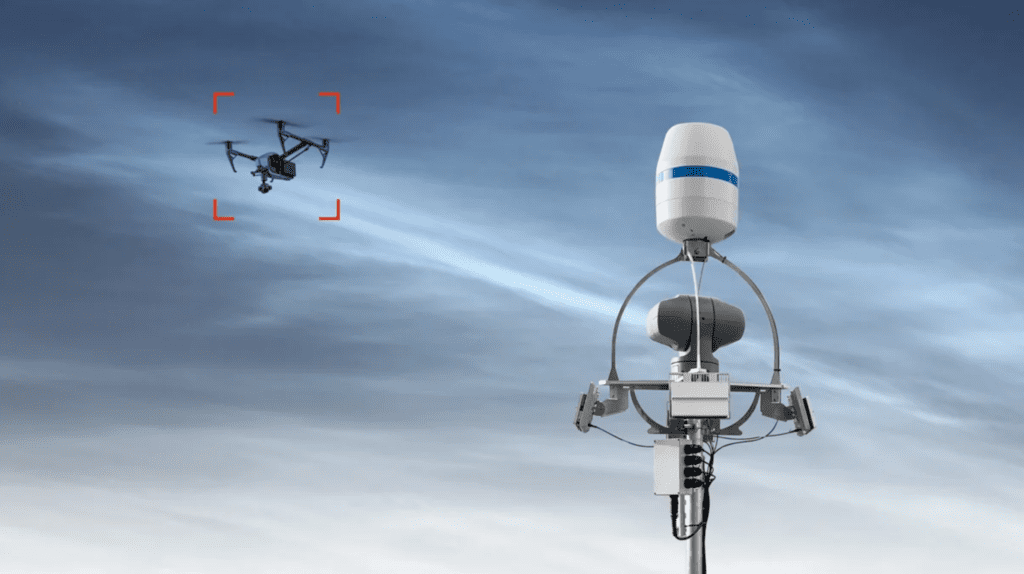最受歡迎的反無人駕駛裝備
產業背景
S系統 C位置
偵測系統
射頻偵測系統
雷達偵測系統
電子光學追蹤系統 (EOTS)
計數器系統
軟性殺蟲設備
無人機干擾器
Drone Spoofer
硬銷設備
雷射齒輪
產業背景
隨著人工智能、通訊技術和航空工程技術的快速發展,無人機器人的應用範圍越來越廣。從商業用途到軍事行動,無人機成為現代社會不可或缺的一部分。

從圖 1 可以看出,全球無人駕駛飛行器市場呈現持續上升的趨勢。這也意味著我們將面臨越來越多的無人機潛在風險。為了加強對無人駕駛飛行器的管理,美國、中國、日本、歐盟等國家相繼出台了無人駕駛飛行器RID管理規範。然而,面對未經授權的無人駕駛飛行活動,簡單的RID模式可能會失效。因此,我們需要更全面的反無人機解決方案。如雷達與光電、軟殺系統與硬殺系統等。
系統組成
在我們開始描述反無人機系統之前,我有兩個問題:
- 如何尋找無人機?
- 如何攻擊無人機?

這也是我們的核心問題。我們建立了反 Uas 系統。
我們從第一個問題開始,「如何找到無人機」。此刻,大家首先想到的可能是雷達。事實上,雷達在無人機偵測中也扮演著重要的角色。在無人機偵測中,主要使用相控陣列雷達。除了雷達之外,還有 RF 偵測裝置和光電追蹤裝置。這些設備中的每一種都可以獨立運行,也可以一起使用,相輔相成。因此,您可以根據自己的財務預算來決定購買這些設備中的哪一種。什麼都買是最好的選擇,如果您的資金有限,那麼選擇 RF 偵測系統將會是最好的選擇。

解決了如何偵測無人機的問題後,我們來談談「如何攻擊無人機」。首先我們把反無人機的方法分為軟殺和硬殺。在日常應用中,最常見的是軟殺設備,如無人機干擾設備、GNSS 詐騙設備等。硬杀伤一般指物理破坏,如激光。
為什麼更多人選擇軟性殺戮?
由於使用電磁波干擾軟消滅設備比較簡單,價格也比較便宜,在體積和重量上都相對比較合適。
然而,軟殺方法存在一些缺陷,對於抗干擾能力較強的特殊 Uav 可能無效。這就是硬殺的用武之地。但軟殺基本可以應對目前絕大多數的 Uav,所以軟殺設備在反無人機中扮演著非常重要的角色。不要小看軟殺設備,目前市面上的軟殺設備可以覆蓋所有的UAV通訊頻段。
雷射作為最強大的硬殺手段,無人機絕對不能忽視它的存在。有人可能會問,為什麼不用槍射擊無人機呢?那不是更好嗎?要知道,由人來操作快速飛行的無人機是很難擊中目標的。激光設備通過檢測的數據引導完成目標瞄準動作 設備。雷射的缺點是昂貴、複雜且射程有限。
上述設備可以集合在一起,形成一個完整的反 UAV 系統,實現發現 UAV 然後反擊 UAV 的任務。這就是我前面提到的兩個問題的答案。我會從這兩方面介紹具體的裝備內容。我會從這兩個方面介紹具體的裝備內容,一個是偵測系統,一個是反制系統。
偵測系統
射頻偵測
什麼是 波譜 偵測:
頻譜感測技術是一種通過分析信號在頻域中的分佈和特性來識別、測量和定位無線電信號的技術。在無人載具頻譜偵測設備中,頻譜偵測技術主要用於即時監測與分析空中無線電信號,從而獲得信號的頻率、頻寬、功率等關鍵參數。
a......的 射頻 偵測:
- 被動偵測,不主動傳送訊號
- 無線電波的傳輸距離足以覆蓋大片區域
- 可實現 UAV 的高精度定位
- 與雷達、光電、聲學和其他 UAV 偵測技術相比,無線電偵測的成本非常低
障礙的優點 射頻 偵測:
- 訊號加密難以破解
- 易受電磁干擾
- FPV 難以定位
雷達偵測
什麼是 相控陣雷達:
相控陣列雷達是相位控制電子掃描陣列雷達。其快速精確的波束轉換能力可使雷達在 1 分鐘內完成整個空間的掃描。所謂相控陣列雷達是由大量相同的輻射元件所組成的雷達陣列。每個輻射元件
由波控制器和移相器獨立控制相位和振幅,可獲得精確且可預測的輻射圖和光束方向。
反 Uas 雷達主要探測 「低小慢 」目標,常使用 X、Ku 波段,綜合雙極化全相干、智能雷達資料處理、多源資料融合等技術,可實現全天候、主動化、多目標、精細化探測 「低小慢目標 」+「低空微氣象 」目標。
a的優點 radar偵測:
- 掃描速度快,光束靈活可控
- 偵測範圍遠
- 目標容量大,可在空域中同時監控和追蹤數百個目標
- 強大的抗干擾能力
- 對複雜的目標環境有很強的適應能力
- 高可靠性
障礙的優點 radar偵測:
- 高成本
- 設備複雜
- 近距離有盲點
- 光束掃描範圍有限
電子光學追蹤系統 (EOTS)
什麼是電子光學追蹤系統:
光電辨識追蹤設備結合了可見光和紅外成像技術,通過光學系統收集目標的光學信息,並將其轉換成電信號進行處理和分析,從而實現對目標快速、準確的辨識和追蹤。
a的優點 電子光學追蹤系統:
- 高畫質攝影機、高精度
- 強大的物件辨識能力
- 即時影像傳輸
- 自動追蹤目標
障礙的優點 電子光學追蹤系統:
- 受環境影響
- 技術複雜性
- 強硬體依賴性
- 光學攝影機較昂貴
計數器系統
透過偵測系統偵測到無人機之後,就需要解決如何防禦無人機的問題。防禦無人機的方式通常分為軟消滅和硬消滅兩大類。軟殺主要通過電子技術實現,硬殺則採用物理破壞。目前,最常用的是軟殺技術,因為其性價比較高,實現難度較低。軟消滅技術應用電磁波技術,通過傳輸相同頻率的信號來干擾無人駕駛飛機的遙控信號和視頻傳輸信號。該技術最早用於無人機干擾設備,後來衍生出無人機欺騙設備。市面上充斥著大量的無人機干擾設備,我們先來討論這一類設備。接著,讓我們來看看無人機誘餌裝置。
無人機干擾器
什麼是無人機干擾器:
利用高頻電磁波技術,將電磁波傳送至與UAV通訊頻段相同的頻段,干擾UAV接收遙控器上的指令,導致UAV無法正常解析遙控器上的指令及影像訊號,進而失去控制,並依預設程序返航或降落。
通常,我們會根據干擾器的結構將其分成幾類,即固定式干擾器、背包式干擾器和手持式干擾器。以下我列出了幾張與這些類型相對應的圖片。
您需要根據您的特定使用情況來決定選擇哪種結構的干擾裝置。(如何選擇合適的干擾器?)
a的優點 無人機干擾器:
- 價格便宜。性價比高
- 可涵蓋多個通訊頻段
- 同時干擾多個目標
障礙的優點 無人機干擾器:
- 干擾距離有限
- 設備功率高
- 不會對無人機造成直接損害,只能迫使無人機返回出發點或安全降落在原地。
Drone Spoofer
什麼是 drone spoofer:
藉由傳送誤導的 GPS 訊號,無人機無法準確取得位置資訊,導致其定位偏移或失去導航能力。
市場上主要有固定式的spoofing設備和可攜式的spoofing設備。全球衛星定位系統(GNSS)偽裝設備在結構上並沒有太大的差異,我們需要關注的是它涵蓋了幾種衛星定位系統的訊號。我們知道全球四大定位系統的主流:GPS、Beidou、Galileo、Glonass。一般而言,我們需要這四個系統的訊號。因為一般的 Uav 至少有兩個 GNSS 定位器,以 DJI 的 Uav 為例,很多可能有三個甚至四個定位器。因此,為了做到萬無一失,我們的欺騙裝置最好能涵蓋所有四種主要的 GNSS。
a的優點 drone spoofer:
- 裝置功耗低
- 它會直接影響無人機的飛行,甚至導致無人機墜毀。
- 覆蓋範圍大於干擾器
障礙的優點 drone spoofer:
- 價格相較於干擾器更貴
- 無法應付無 GNSS 功能的無人機
- 它會影響區內所有裝置的 GNSS 功能


